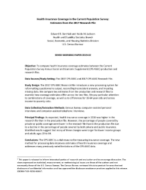Health Insurance Coverage in the Current Population Survey: Estimates from the 2017 Research File
Health Insurance Coverage in the Current Population Survey: Estimates from the 2017 Research File
Introduction
Researchers and government agencies rely on federal surveys, particularly the Current Population Survey Annual Social and Economic Supplement (CPS ASEC), to measure health insurance coverage. CPS ASEC estimates are used to allocate billions of dollars in children’s health insurance funds (Davern et al., 2003) and to score Congressional legislation (Glied et al., 2002). The CPS ASEC is also a particularly valuable source of information about variation in coverage across economic and demographic groups. As a result, the CPS ASEC is one of the most cited sources for health insurance coverage estimates (Davern and Blewett, 2006).
A large body of research has evaluated the quality of CPS ASEC health insurance data and identified some key limitations (see U.S. Census Bureau, 2015 for an overview). Namely, the CPS ASEC health insurance questions (Hess et al., 2001; Pascale, 1999) and imputation process (Davern, 2007; Kenney and Lynch, 2010) tended to underestimate coverage.
The 2017 CPS ASEC Research File addresses some of these limitations and introduces updated, modern strategies for cleaning and imputing demographic, income, and health insurance data. This is the second major step in a redesign of the health insurance section, and seeks to improve data quality amid a changing health insurance landscape.




